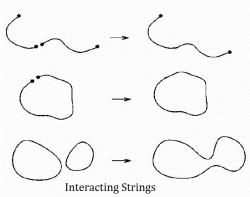String Theory on Youtube
In the midst of other posts, I plan to highlight online videos of talks, interviews, lectures, etc. in an effort to collect some good resources on theoretical physics and cosmology.
Recently I have been working through a series of videos (starting here) from Stanford featuring a course on string theory, with Leonard Susskind. You can watch them yourself, although they’re quite long. Here I’ll just boil down some of the key ideas:
Strings, like fields, can be described as a collection of masses connected by springs – except, we’re taking the continuous limit where there are an infinite number of infinitely small masses and springs chained together. This is very similar to the description of a field in quantum field theory – in that case the masses fill all of space, and each is attached or “coupled” to its neighbors with a spring. The continuous limit gives us a field.
As with particles, fields, spacetime, and just about anything else in physics, we can talk about a classical string or a quantum string. A classical string has a definite shape at each moment in time: each of the masses oscillate back and forth and pull on their neighbors via the connecting springs. When we talk about a quantum string, each of the masses is treated as a quantum harmonic oscillator (again, this is just like the description of a quantum field, in which case there is an oscillator at each point in space). Because the constituent masses no longer have definite positions, the quantum string doesn’t have a definite shape. Instead, like anything quantum mechanical, it is described by a wave function, which tells you the likelihood (actually, the “amplitude”) for any particular shape – that is, how much different shapes contribute to the quantum state of the string.
(Funny fact: a string can pass through itself – so you would have trouble tying knots – because each point on it only interacts with its immediate neighbor points, and thus isn’t sensitive to some distant patch on the string.)
A string can be in its ground state (state of lowest energy), or in an excited state. Different particles, such as photons or gravitons, emerge as different excited states of the same string. Excited states can be described in terms of little waves propagating around the strings.
Strings can be open or closed – that is, with two free ends, or joined in a loop. Excited states of a closed string can act like the graviton (the particle which mediates the gravitational force), whereas excited states of an open string can act like the photon (the particle which mediates the electromagnetic force).
Strings can join together into one, or break into two – this is where scattering and decaying of particles comes from. A “coupling constant” or “interaction strength” (similar to the strength of an electric force, for example), tells you how common it is for strings to break or join.
If you’re interested in more, check out the video link above.
Why am I telling you all this? Aside from the fact that it’s fascinating as a theory in itself, regardless of any connection to the real world, string theory can lead to physics we know when you “zoom out” to scales where you can’t distinguish strings from point particles. So it may be the right way to describe the world at extremely small scales! Either way, it can give us new understanding of the mathematical structure of theories which do describe our world, such as quantum field theory and general relativity, which emerge from string theory in certain limiting regimes of the parameter space.

